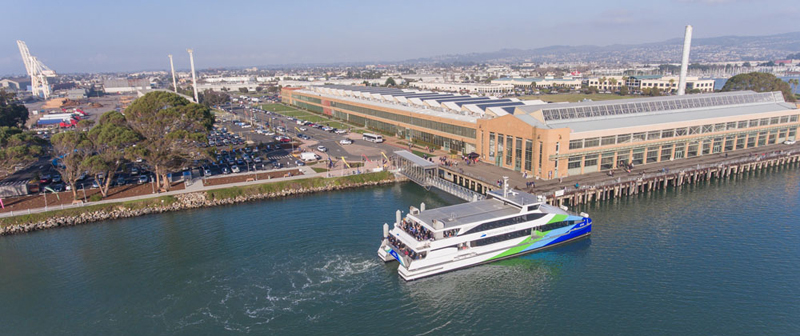
The San Francisco Bay Area Water Emergency Transportation Authority (WETA), Contra Costa Transportation Authority (CCTA) and City of Richmond celebrated the launch of Richmond ferry service and the opening of the Richmond Ferry Terminal on Thursday, January 10, 2019. This new service continues the ambitious expansion of WETA’s regional San Francisco Bay Ferry system, helps alleviate traffic congestion and increases WETA’s emergency water transit response capabilities.
“We are thrilled to launch new ferry service between Richmond and San Francisco,” said Nina Rannells, WETA’s executive director. “This new weekday commute service will improve the lives of East Bay residents by getting them off of the congested freeways and onto the bay with a safe, reliable and enjoyable alternative.”
The new San Francisco Bay Ferry Richmond service will offer four peak direction and two reverse commute trips between Richmond’s Ford Point and the San Francisco Ferry Building during weekday morning and evening commutes. The Richmond Ferry Terminal project included the construction of an accessible gangway with a new ramping system, float and piles, a passenger shelter and the development and reconfiguration of a 362-space paved parking lot. WETA also installed a new ADA-compliant kayak launch ramp and improved shoreline access at Ford Point.
“For as long as I have been on the City Council — 23 years — we have been advocating for permanent ferry service,” said Richmond Mayor Tom Butt. “It’s been a prolonged effort including many agencies and local officials, but we are finally here. Richmond evolved as a waterfront community, and ferries are a significant part of our heritage. It’s thrilling to be back in business.”
WETA has invested $465 million in recent years in new ferry assets – including new terminals, maintenance facilities and vessels – to support its mission to expand regional ferry service in the San Francisco Bay Area. Over the last two years, WETA has added three new vessels to its fleet, opened the Ron Cowan Central Bay Operations and Maintenance Facility in Alameda and experienced unprecedented demand for ferry service, now carrying nearly 3 million passengers annually. Two new vessels are on track to join the San Francisco Bay Ferry fleet in the first quarter of 2019, and three more are currently under construction.
Contra Costa’s Measure J transportation sales tax will fund operations of the Richmond ferry service for at least 10 years through an agreement between CCTA and WETA.
“The Contra Costa Transportation Authority is proud to be a funding partner of this new ferry service, which is creating a stronger connection between Contra Costa County’s communities and the Bay Area region,” said Federal Glover, CCTA’s Board Chair. “Providing commuters with more options to travel to and from work helps make our county a more desirable place to live, to operate a business and to raise a family.”
Looking to the future, WETA has developed a 20-year strategic plan with an ambitious vision that would expand WETA’s regional ferry system to include 44 vessels, 16 terminals and 12 routes that would serve to increase peak period capacity 740 percent by 2035.
The Richmond Ferry Terminal project was funded by Regional Measure 2 (RM2), State Proposition 1B and U.S. Department of Transportation funds. The total project cost for design and construction was $20 million. The project team included Manson Construction Co. and COWI North America, Inc., Marcy Wong Donn Logan Architects and GHD Inc., and Ghirardelli Associates, Inc.


